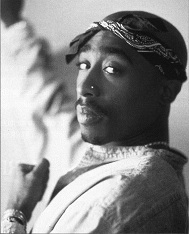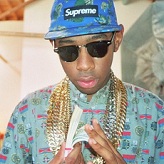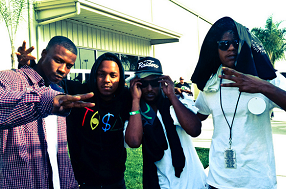The Ghost Of Tupac Shakur [Editorial]
Apr 24 2011
 On September 13, 1996, a deafening silence fell across the entire state of California. At the University Medical Center doctors rushed in a panic as they tried to save the life of a young 25 year old man with internal bleeding caused by multiple gunshot wounds. The crowded room filled with surgeons and assistants suddenly moved in slow deliberate actions as time seemingly slowed down to a sluggish pace. As doctors attempted to revive the young man, his own mother made the hardest decision any mother would ever have to make. She called for the doctors to stop. At 4:03 PM, Tupac Shakur was pronounced dead. Looking back on this day, it is almost like imagining a blanket of darkness falling on hip hop at that exact moment. Well over a decade after he was fatally shot, Tupac’s message continues to resonate with both listeners and MCs on the West Coast. His revolutionary and brash personality was better described as schizophrenic. At any given moment, Shakur’s voice would boom with the controversy and ideals of a Black Panther. Other times, Tupac was just a forty and gun away from living the thug life. The complexities behind his music and life gave way for one of hip hop’s greatest legacies. Today, the West Coast keeps pushing forward trying to fill the void left behind by Tupac. No, no one is trying to replicate or become the next Pac. Most of us could not imagine any one person braving the criticism for such a thing. Instead, the new generation of West Coast MCs carry a lot of Pac’s traits. The new breed, which has been tagged as the New West, move with a rebellious nature that calls back to Pac’s early days in the game. This bold generation of artists that places emphasis on real music over radio hits is currently controlling the movement of the West Coast, and just like Pac, they won’t be changing for anyone.
On September 13, 1996, a deafening silence fell across the entire state of California. At the University Medical Center doctors rushed in a panic as they tried to save the life of a young 25 year old man with internal bleeding caused by multiple gunshot wounds. The crowded room filled with surgeons and assistants suddenly moved in slow deliberate actions as time seemingly slowed down to a sluggish pace. As doctors attempted to revive the young man, his own mother made the hardest decision any mother would ever have to make. She called for the doctors to stop. At 4:03 PM, Tupac Shakur was pronounced dead. Looking back on this day, it is almost like imagining a blanket of darkness falling on hip hop at that exact moment. Well over a decade after he was fatally shot, Tupac’s message continues to resonate with both listeners and MCs on the West Coast. His revolutionary and brash personality was better described as schizophrenic. At any given moment, Shakur’s voice would boom with the controversy and ideals of a Black Panther. Other times, Tupac was just a forty and gun away from living the thug life. The complexities behind his music and life gave way for one of hip hop’s greatest legacies. Today, the West Coast keeps pushing forward trying to fill the void left behind by Tupac. No, no one is trying to replicate or become the next Pac. Most of us could not imagine any one person braving the criticism for such a thing. Instead, the new generation of West Coast MCs carry a lot of Pac’s traits. The new breed, which has been tagged as the New West, move with a rebellious nature that calls back to Pac’s early days in the game. This bold generation of artists that places emphasis on real music over radio hits is currently controlling the movement of the West Coast, and just like Pac, they won’t be changing for anyone.
 The entire nation got a taste of just how wild and unpredictable these new cats really are when the Odd Future Wolf Gang collective tore the house down on Late Night With Jimmy Fallon. The pack of ravenous MCs, led by Tyler The Creator, gave a jaw dropping performance that was more suiting of a 1993 Wu-Tang show than a modern day rap act. Watching the performance was like taking a ride back in time to the first time The Beatles invaded the airwaves on the Ed Sullivan Show. For much of America, this was the first time they had been exposed to Odd Future. The reality is, that Odd Future had been quietly building a cult following all across the nation through their various online releases, and the support of numerous blog sites. The unorthodox group is made up of Tyler, Hodgy Beats, Earl Sweatshirt, Domo Genesis, Mike G, and Frank Ocean with several others who work as producers and engineers. The punk/rap hooligans made waves through the industry when a two-stop tour sold out immediately, with the group playing in London and New York, respectively, for the first time. Audiences at both performances were subjected to violent moshing, crowd surfing, and relentless taunting from Tyler. Looking past the insanity and completely absurd lyricism, there are a similarities to draw from Tyler’s fearlessness and Tupac’s “I don’t give a fuck” attitude. Watching interviews of Tyler blurt out obscenities and challenge pretty much anything or anyone, a quick flash in memory shows an image of Tupac running his mouth in front of a camera, waving money around. Tupac, with Dr. Dre and Suge Knight at his side, talked to the camera and challenged anyone in the industry to face the new Death Row Records. Speaking as a recently free man, Tupac personified what it was to truly not care one bit. He antagonized watchers and took numerous veiled jabs at Biggie. What was it that motivated the behavior? Was Pac just in a rabidly vicious mood, or did he want to get a reaction out of people? If there was one thing Tupac was very good at, it was toying with the public’s perception of reality. Tyler The Creator could be dropped in the same category. The 23 year old MC knows that his words can illicit more anger and outrage from the public than any stunt he could pull on stage. Pissing people off is the name of the game, and right now, Tyler The Creator is the best player.
The entire nation got a taste of just how wild and unpredictable these new cats really are when the Odd Future Wolf Gang collective tore the house down on Late Night With Jimmy Fallon. The pack of ravenous MCs, led by Tyler The Creator, gave a jaw dropping performance that was more suiting of a 1993 Wu-Tang show than a modern day rap act. Watching the performance was like taking a ride back in time to the first time The Beatles invaded the airwaves on the Ed Sullivan Show. For much of America, this was the first time they had been exposed to Odd Future. The reality is, that Odd Future had been quietly building a cult following all across the nation through their various online releases, and the support of numerous blog sites. The unorthodox group is made up of Tyler, Hodgy Beats, Earl Sweatshirt, Domo Genesis, Mike G, and Frank Ocean with several others who work as producers and engineers. The punk/rap hooligans made waves through the industry when a two-stop tour sold out immediately, with the group playing in London and New York, respectively, for the first time. Audiences at both performances were subjected to violent moshing, crowd surfing, and relentless taunting from Tyler. Looking past the insanity and completely absurd lyricism, there are a similarities to draw from Tyler’s fearlessness and Tupac’s “I don’t give a fuck” attitude. Watching interviews of Tyler blurt out obscenities and challenge pretty much anything or anyone, a quick flash in memory shows an image of Tupac running his mouth in front of a camera, waving money around. Tupac, with Dr. Dre and Suge Knight at his side, talked to the camera and challenged anyone in the industry to face the new Death Row Records. Speaking as a recently free man, Tupac personified what it was to truly not care one bit. He antagonized watchers and took numerous veiled jabs at Biggie. What was it that motivated the behavior? Was Pac just in a rabidly vicious mood, or did he want to get a reaction out of people? If there was one thing Tupac was very good at, it was toying with the public’s perception of reality. Tyler The Creator could be dropped in the same category. The 23 year old MC knows that his words can illicit more anger and outrage from the public than any stunt he could pull on stage. Pissing people off is the name of the game, and right now, Tyler The Creator is the best player.
 The mixture of a gangsta rapper and revolutionary is no doubt a strange one. To think that an individual pushing for progress could be the same one smacking women and brandishing handguns is a little disturbing. The anger and pain of the black struggle in America was a part of Tupac’s blood. His mother and father had both been active participants of the Black Panther party throughout the 60’s and 70’s. Tupac’s motivation was akin to that of Malcolm X: by any means necessary. If you weren’t going to help the progress, they were going to take it from you. The make up of today’s New West movement is highlighted by the cutting edge group known as Black Hippy. Borrowing from the same age old values, Black Hippy represents the modern day mix of hood tales and politically motivated records. Led by the one-two punch of Jay Rock and Kendrick Lamar, Black Hippy also includes Schoolboy Q and Ab-Soul. The four MCs have paved the way for independent artists looking to make an impact on West Coast hip hop. With no major label behind them, the group pushes consistent releases from their own Top Dawg Entertainment imprint. Every release is a product of the group’s DIY attitude, which includes a modest home studio where they spend most of their days recording and mixing. With their edgy and hardened exterior, Black Hippy could be easily dismissed as just another gun toting by product of L.A.’s gang scene. The truth is, Black Hippy is reinventing the sound of West Coast hip hop. Nothing about their music is typical or generic. Between soulful and passionate production, and their mean streak on beating up bars like it’s nothing, Black Hippy is a hip hop head’s wet dream. Jay Rock takes on the role of hood general with his trademark growl that cuts through a track with sincere pain and hunger. Kendrick Lamar’s flow is quite possibly the most vulnerable and honest to be heard in a very long time. Between the two, an oppositional take on West Coast life is molded, and watching it unfold is like watching students of Tupac’s music spread their wings. Black Hippy’s bi-polar agenda is best represented on their “Constipation” record. Listening to the four MCs trade bars covering everything from political struggles to black America, it’s hard to not think of Pac’s rhetoric. When discussing their name, Ab-Soul explains that they believe all colors come from black, in this case, they spread the influence of black music throughout the industry. Black Hippy may not consider themselves political revolutionaries, but the more they progress and break down barriers, the more they leave a mark on the next generation. A closer look at Black Hippy reveals four individuals who embody the multiple and sometimes contradictory facets that lived within Tupac’s music.
The mixture of a gangsta rapper and revolutionary is no doubt a strange one. To think that an individual pushing for progress could be the same one smacking women and brandishing handguns is a little disturbing. The anger and pain of the black struggle in America was a part of Tupac’s blood. His mother and father had both been active participants of the Black Panther party throughout the 60’s and 70’s. Tupac’s motivation was akin to that of Malcolm X: by any means necessary. If you weren’t going to help the progress, they were going to take it from you. The make up of today’s New West movement is highlighted by the cutting edge group known as Black Hippy. Borrowing from the same age old values, Black Hippy represents the modern day mix of hood tales and politically motivated records. Led by the one-two punch of Jay Rock and Kendrick Lamar, Black Hippy also includes Schoolboy Q and Ab-Soul. The four MCs have paved the way for independent artists looking to make an impact on West Coast hip hop. With no major label behind them, the group pushes consistent releases from their own Top Dawg Entertainment imprint. Every release is a product of the group’s DIY attitude, which includes a modest home studio where they spend most of their days recording and mixing. With their edgy and hardened exterior, Black Hippy could be easily dismissed as just another gun toting by product of L.A.’s gang scene. The truth is, Black Hippy is reinventing the sound of West Coast hip hop. Nothing about their music is typical or generic. Between soulful and passionate production, and their mean streak on beating up bars like it’s nothing, Black Hippy is a hip hop head’s wet dream. Jay Rock takes on the role of hood general with his trademark growl that cuts through a track with sincere pain and hunger. Kendrick Lamar’s flow is quite possibly the most vulnerable and honest to be heard in a very long time. Between the two, an oppositional take on West Coast life is molded, and watching it unfold is like watching students of Tupac’s music spread their wings. Black Hippy’s bi-polar agenda is best represented on their “Constipation” record. Listening to the four MCs trade bars covering everything from political struggles to black America, it’s hard to not think of Pac’s rhetoric. When discussing their name, Ab-Soul explains that they believe all colors come from black, in this case, they spread the influence of black music throughout the industry. Black Hippy may not consider themselves political revolutionaries, but the more they progress and break down barriers, the more they leave a mark on the next generation. A closer look at Black Hippy reveals four individuals who embody the multiple and sometimes contradictory facets that lived within Tupac’s music.
Following his death, a slew of previously unreleased records guaranteed that fans of Tupac’s music would never have to go without hearing his voice again. For many, he lives on through his records and multiple film roles. For those willing to look closer, he lives on through the music of today’s best MCs. The vastly diverse group of MCs who are now considered the New West, each carry a piece of Tupac’s influence with them. True, we may never hear another like him. Tupac Shakur was many things, but he was also one of a kind. Still, watching a generation of artists who came up listening to Pac, it shouldn’t be surprising to sometimes faintly see him in each and every one of them. Those of us still searching for Tupac need to listen closer because he’s been with us this whole time.
-Victor Sandoval, Assistant Editor Strange Music Blogs
Follow Victor On Twitter: @VicMSandoval
Categories
None
